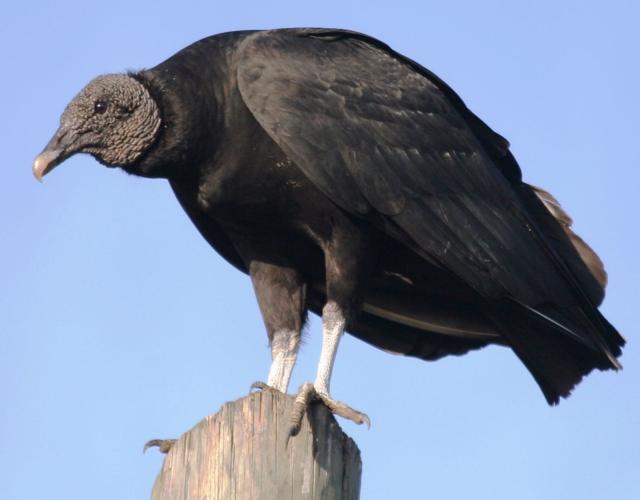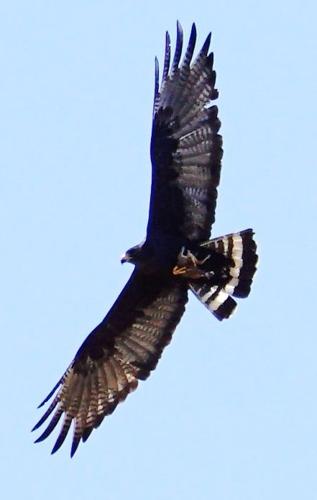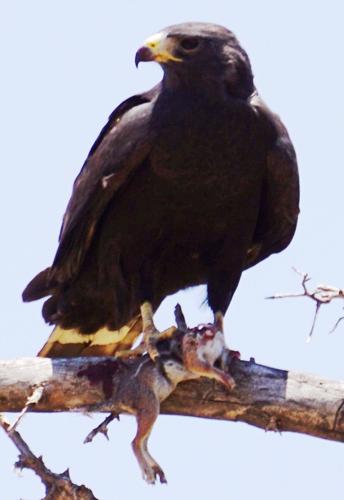There are two species of vultures found in the U.S. and both are seen in southern Arizona. For the most part, Turkey Vultures (the more widespread and common) are Arizona migrants, flying up from Mexico in the spring to nest and vacation here before returning to their winter grounds in the fall. The smaller Black Vulture is a year-round resident of southern and southeast states, and although rarely seen in the SaddleBrooke area, is readily found in Pinal County’s Santa Cruz Flats. Turkey Vultures are distinguished by their large size, soaring and gliding high in the summer sky, wings raised dihedral and rocking side-to-side. From below, their silver and black plumage is distinctive, as is (if you can see it) their small naked head, red in adults but black in juvenile birds. By contrast, Black Vultures have shorter wings and tails, and appear solid black from below except for diagnostic silver-white wingtips. Their head color also differs from their cousins - black for juveniles and gray for adults. Both vultures feed on carrion, and you’ll often scatter them from feasting on road kill when you drive back roads. Neither species has much to say and Sibley describes their voice as soft hissing, barking, clucking and whining like some golfers I know.
So, in this part of the country when you look up and see a large black bird soaring and sailing gently high in the sky, it’s most often a vulture and around here most likely a Turkey Vulture, but not always. A similar-looking, but quite different bird found here during the same time of year, is the Zone-tailed Hawk. This is a relatively rare bird in the U.S. with a total of perhaps only 300 nesting pairs; a bird typically seen here only in Arizona, New Mexico and Texas, and often mistaken for a Turkey Vulture when it is seen. The Zone-tailed Hawk is close to the Turkey Vulture in size, has a near-identical underwing pattern of black and silver and soars and sails like the vulture. And to add to the confusion, the Zone-tailed is often found together with Turkey Vultures, sailing alongside one or two or even mixed in with a larger kettle of vultures. From a distance, distinguishing one from the other is difficult at best, and if it weren’t for the white tail bands on the hawk it would be near impossible. So next time you’re inclined to shake off circling black birds as “just vultures,” raise your binoculars and take a closer look. You could find one of those 600 rare hawks. At least one nesting pair has been documented in the Canada del Oro Wash near SaddleBrooke’s Preserve, and we’ve seen a solitary Zone-tailed Hawk numerous times from our yard.
Zone-tailed Hawks have nothing in common with Turkey Vultures, so you might ask what’s up with this. And, as usual, there’s an answer. Turns out this is intentional deception, with the hawk taking advantage of his similar appearance and likely evolving it over time through genetic selection. Vultures eat road kill and other well-dead critters. Zone-tailed Hawks like hot-blooded fresh meat like rabbits and rodents, neither of which are known for their keen eyesight. Suppose you’re a bunny enjoying a sunny morning, shopping for produce and a dark shadow passes over. You pause and take a weak-eyed look skyward, seeing only a couple of vultures circling slowly in the summer heat, looking for dead stuff, right? So you lower your head and go back to the veggies - not always the right move.
If you have questions or comments about SaddleBrooke’s birds, or to receive emailed information about bird walks led by Bob and Prudy, call 825-9895 or email bobandpru@aol.com. Previously published articles can be found atwww.birdingthebrookeandbeyond.com.






